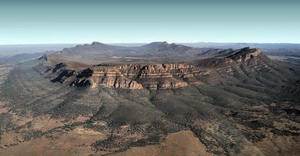In several previous Picture of the Day articles we have considered the geological history of the Australian continent and found that there are several disconformities in the appearance and structure of many formations. The famous "Red Center" is particularly noteworthy because Uluru, Kata Tjuta and other monolithic stone tors stand in isolated grandeur above the relatively flat landscape.
The Flinders Range is a rugged outcrop of sandstone and quartzite that begins about 250 kilometers north of Adelaide and stretches for 800 kilometers. The mountains are extensively folded and fractured, with several deep gorges cut through them. One of the most unusual features in the range is Wilpena Pound, a natural amphitheater of stone covering 83 square kilometers, with interior dimensions of 11 kilometers by 8 kilometers.

|
| ©Unknown |
| Wilpena Pound, Flinders Range, South Australia |
The conventional view of the Flinders Range sees it forming over 650 million years ago as sediments in a now extinct ocean. Earth movements pushed the materials upward into a dome-shape that has been subsequently worn down through the natural processes of erosion by wind and water. Over the millennia, the surrounding peaks have diminished and the hills and valleys have vanished into the dust and sand of the great desert. As the standard theory goes, although Wilpena Pound appears to be the remains of a meteor impact the overall shape and the stratigraphic composition do not support that idea.
As has been pointed out in the past, however, erosion does not possess the all-encompassing power for change that modern geology asserts. In our Picture of the Day about Shiprock, New Mexico the dual-ridge faults, the curved gullies that stretch out from a common center, and the sharp ridges with sine wave undulations incised into them were all said to be the remains of lightning bolts of continental dimension cutting into the topography like a plasma knife.
Within Wilpena Pound is the Edeowie Gorge. A striking example of vitrification can be found there, since the gorge reveals sheets of pale yellow glass buried under the sandstone overburden. The glass is extremely pure with no admixture of soils or mineral inclusions, very much like the Egyptian "desert glass" that is found in the Great Sand Sea near the Libyan border. Both glass deposits also contain dark wisps of iridium and tiny bubbles of cristobalite - features that point to the application of exceptionally high temperatures when the glass was created.
The desert glass is associated with an enormous crater called Kebira that was recently discovered by analyzing images taken from earth-orbit. The 32-kilometer-wide depression is said to be the ancient remains of an asteroid impact, but there is little indication of a crater and there are multiple sharp peaks in its center. Such attributes have been discussed elsewhere and have been theorized to be from electric arcs fusing the sands into molten glass and then blasting the chunks outward over a wide area.
Taken together, the fused sand, the scalloped edges of the ridge surrounding Wilpena Pound, the iridium, the raised rim, the curvilinear gullies and the other geological anomalies all point to electrical activity as the causative agency for its creation. The conventional geological viewpoint is insufficient when it comes to explaining the many bizarre landforms in Australia.



Reader Comments
to our Newsletter